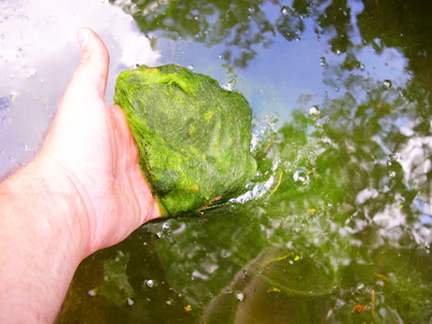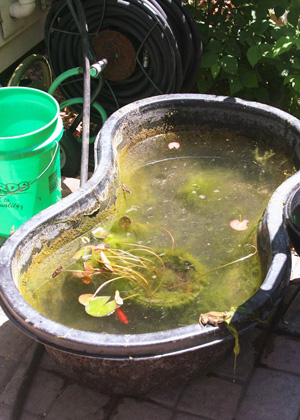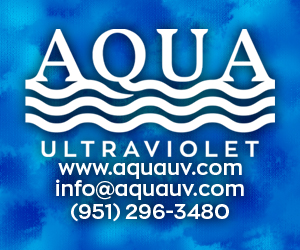This article is an update of an earlier post.


Before you can begin mastering string algae, you have to learn to recognize string algae in your pond. String algae is a filamentous (stringy filament) species of plant, and is most often found hanging off the sides of rocks or covering the water’s surface. It can quickly grow in weight and length, so it’s best to keep control of string algae as soon as it is noticed. String algae often clumps and tangles together to form thick blanket like mats — analyze the mats to tell whether it is made of many individual strings. If so, you’re dealing with string algae.
Is String Algae Harmful?
Though it may appear ugly, string algae is not a major danger to your fish’s health but it can be a nuisance to water quality and pond appearance.This unsightly green mess tends to adhere directly to rocks. It should not be confused with the good algae which forms on the side of the pond and is soft, velvety, and jelly-like.
It can, however, be a harmful problem if not solved carefully. Many of the methods that remove string algae have a potentially fatal effect, which is why this article’s instructions need to be followed carefully.
Unfortunately, solving a string algae problem is not a one-day process. Like most water management techniques, regaining balance after a string algae issue has a varied timeline depending on severity: as short as one week to as long as three months.
1. Extract the String Algae Physically
No matter how you go about this process, this first step is essential to begin the recovery process. Physical removal is the fastest way to get algae out of your pond so you can move to the next step. To gain leverage and easily pull the algae out, simply wrap the end of the algae around your hand or fingers and pull the algae from it’s root. If the algae is at any sort of depth or extreme in length, you may need to use an elongated tool such as a pole or broomstick to wrap the algae around.
2. Identify the Cause of String Algae
Look for potential causes of string algae by testing your water quality. The most common root causes of string algae are high pH and Phosphorous (P) levels in the water. Once recognized, then you can adjust your pond chemistry accordingly.
Lowering Your pH Levels
High pH a levels can result from the clearing of algae blooms, excessive plant growth, overstocking of fish, and the introduction of foreign materials (untreated concrete, rocks containing limestone or calcium/granite). To reduce pH take the following steps.
- Clear algae blooms outside of your string algae problem
- Remove or trip overgrown plants
- Transfer fish to a new pond
- Experiment with removing rocks that may be contributing (often calcium, limestone)
Lowering Your Phosphorous Levels

High phosphorous levels are commonly caused by fertilizers leaking into the pond water. Iron is also a major contributor as well as grass clippings that find their way into the pond after mowing the lawn. To reduce phosphorous levels we recommend the following steps:
- Make sure no fertilizers are entering your pond (can be water run-off or direct)
- Remove any algae blooms
- Scoop out any grass clippings that may have fallen into your pond
- Grow an Anacharis plant if the problem persists. This plant feeds on phosphorous.
Although adjusting the pH and phosphorous levels will set the environment for less algae growth, you must take additional steps to actively work against the algae. This is the key to mastering your algae problem.
3. Treat Water and Kill Off Remaining Algae
There are two basic ways to treat the area after a string algae infection: chemical alteration/algaecide or natural bacteria/enzymes. Neither major category is superior by nature, although the natural method is often far safer.
Examples of Chemical Methods
- Dose Hydrogen Peroxide (3% peroxide, approx. 16oz per 1,000 gallons)
- Pond Algaecides (Use varies by product, choose carefully and no copper based additives)
Examples of Natural Methods (Can Be Used In Combination)
- Provide shade coverage over the treatment area
- Use bacteria or natural mineral based algae additives
- Enhance your filtration – trickle tower filtration method is best for this cause
I recommend a combination of natural methods to solve a string algae problem, depending on the intensity of the issue. Chemical methods may provide a faster solution to your issue, but without exact measurement they can lead to harm or even fatal consequences for your fish. Many algaecides also negatively affect the “good” bacteria designed to help keep a pond cleaner. Once these are wiped out, algae can grow more readily and may force a pond owner into a never-ending cycle of chemical use.
It’s important to note that UV Lights will not be effective in removing string algae. String algae is attached to different parts of your pond and therefore will not flow past the UV light.
4. Add Extra Plants and Remove Decay
You’ll want to add plants to your pond to provide extra oxygen and to attract snails that will consume string algae. The key here is to bring in plants that have high potential nutrient consumption. Water Lettuce, Cattails, and Irises during warmer months will help you fight against algae. The Water Hawthorne is the best plant for colder or winter months. These plants will out-compete the string algae for nutrients, making it nearly impossible for the algae to return. Not to mention, adding a lovely plant to your pond environment can never hurt.
5. Feed Fish Less!

Overfeeding fish is one of the most common issues we see among pond owners. Not only do overfed fish let off ammonia and other potentially harmful chemicals, but if the fish overeat then they won’t have room for other substances in the pond. That’s right, like algae! A key measure of whether you are overfeeding is whether there is food left in the pond after feeding. Your fish should be hungry enough to finish all the food, and full enough to stay healthy.
Pro tip: adding corbicula clams to your environment will make your life much easier. These clams actively filter 1.5 Liters per hour for nutrients!
Fighting string algae can take a lot of time, but if you’re doing it the right way it won’t take many resources. In many cases, removing this problem provides an opportunity for pond owners to add a variety of plants, snails, clams, and other algae-feeding inhabitants to the pond.
>> Read “How to Get Rid of String Algae in Your Pond” for more information on the topic



Best site I’ve read most helpful, now I think I can fix the problem. Thank you.
I have a koi pond with a nice blanket of string algae. It is short and stays that way. But I have been told it is just string algae that the koi are keeping short. Is this true? I have had string algae once before and it was out of control. It seems to me that it is a different type of algae. But a knowledgeable person told me it is the same stuff???
We will need to look at some pics to identify what you have. We have a web link to troubleshooting which allows you to upload pics and engage with troubleshooter. Here is the link..https://nualgiponds.com/pond-diagnosis-form/
I realize this is an old post and did submit a question to the troubleshooting link. But nowhere can I find out how to dispose of the string algae after removing it from the pond by hand. I have some in buckets, but threw a lot into flower gardens. I removed the rocks that were covered and the algae dried, but will it com back even after drying once it get wet again?
Should I NOT put the rocks back in?
Your sight sucks if you don’t answer the questions.
I don’t see any comments on the site about this article from you John. The other questions that people asked about this article have been answered.
Agreed. Thank You Lora
Do you know if this algae can be used as fertilizer?
Algae can be used as a fertilizer because it is a living organism. When algae is used as a fertilizer, it quickly begins to break down releasing its abundant nitrogen source. As a result, algae can act as an excellent fertilizer that can be used to help grow crops efficiently
Will string algae kill my plants?
Yes, unfortunately, if you do not deal with the algae, it can quickly deplete the pond’s oxygen which would negatively affect ornamental plants and fish. Plants can be helpful in the fight against string algae, since they remove excess nitrates.